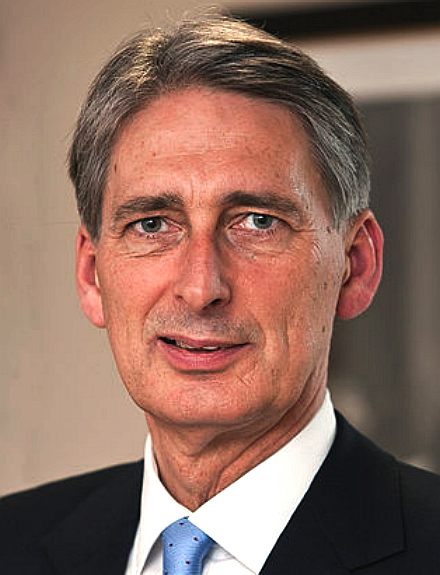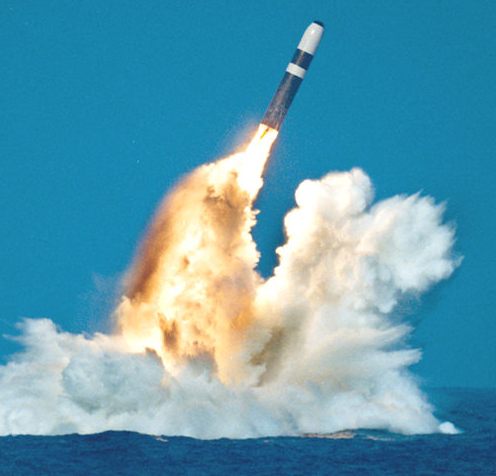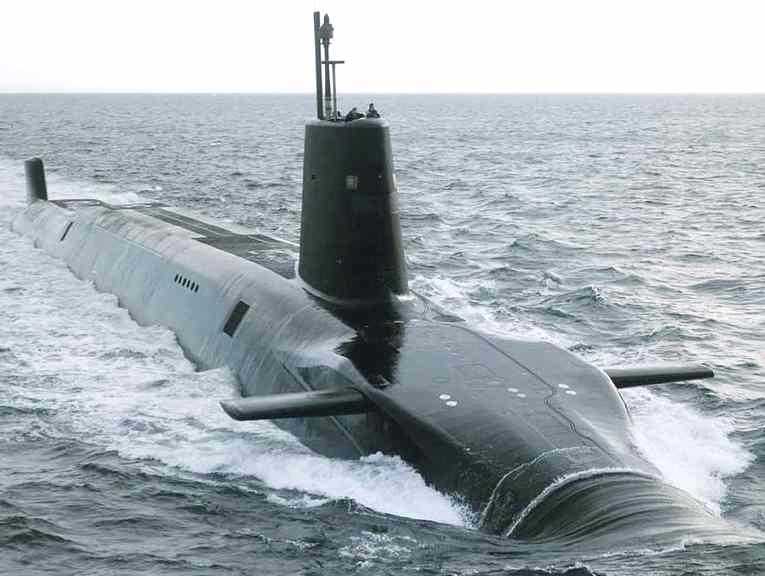|
TRIDENT SUBMARINE MISSILE SYSTEM
|
|||||||||||||||||||||||||||||||||
|
2021 - UK Prime Minister, Boris Johnson, and the former Secretary of State for Defence, Philip Hammond. The Prime Minister is set to break United Nations international law, in seeking to increase the Britain's nuclear arsenal, in denial of the UN's resolution, that became law in 2021.
Monday 29 October 2012
Nick Clegg’s spokesman has briefed journalists on the Liberal Democrat position on nuclear weapons. He said that today’s news that
Philip
Hammond, the Defence Secretary, was spending £350m on the design phase of the Trident replacement does not mean that the Lib Dems have given up their opposition to a “like-for-like” replacement.
Phil Hammond
Philip Hammond MP (born 4 December 1955) is a British Conservative Party politician. He is Secretary of State for Defence in the Coalition government led by David Cameron, having succeeded Liam Fox on 14 October 2011. He was Secretary of State for Transport from 13 May 2010, when he was appointed as a Privy Counsellor. He is the Member of Parliament (MP) for Runnymede and Weybridge.
Wednesday June 28, 2006
Chancellor Gordon Brown has defended his decision to back the renewal of Britain's nuclear weapons system. The Kirkcaldy and Cowdenbeath MP announced last week that he favoured replacing Britain's ageing submarine-based Trident system. But the decision was criticised by church leaders in Scotland, who said it undermined his commitment to overseas aid.
Gordon Brown MP
A decision is expected on Trident before the end of this year and Mr Brown may even be the one to make it, if he has replaced Tony Blair as Prime Minister. He said on Wednesday, almost a year after the Make Poverty History march in Edinburgh, that this could be done in tandem with spending on Third world aid.
"I think what people do know is that we've managed to ensure the defence and security of this country, in a world where we are prey unfortunately, to terrorist threats," he told BBC Reporting Scotland. "At the same time, we've managed to show that we can double overseas aid, we can increase investment in Africa three-fold, we can create a vaccination facility that will ensure that five million children live rather then die.
"I think we've proved that what governments have got to do, you must have defence and security in the modern age and you must be able to help those in greatest need. We're doing both." Both the Chancellor and the Prime Minister were elected on an anti-nuclear manifesto in 1983. But he played down the suggestion that the estimated £12-25 billion to fund a new nuclear weapons system should go to fight poverty.
THE TRIDENT NUCLEAR MISSILE SYSTEM
The Trident missile, named after the trident, is an intercontinental ballistic missile (ICBM) which is armed with nuclear warheads and is launched from submarines (SSBNs), making it a SLBM.
The Trident was built in two variants: the I (C4) UGM-96A and II (D5) UGM-133A. The C4 and D5 designations put the missiles within the "family" that started in 1960 with Polaris (A1, A2 and A3) and continued with the 1971 Poseidon (C3).
Both Trident versions are three-stage, solid-propellant, inertially guided missiles whose range is increased by an aerospike, a telescoping outward extension that halves frontal drag.
The Trident is carried by fourteen active US Ohio class submarines and (with British warheads) four UK Vanguard class submarines.
The launch from the submarine occurs below the ocean surface. The missiles are ejected from their tubes by gas pressure created by a "gas generator", a solid-fuel rocket motor attached to the bottom of the missile tube which heats a pool of water creating steam. After the missile leaves the tube and rises through the water over the submarine, the first stage motor ignites, the aerospike extends, and the boost stage begins. Ideally, the missile is "sheathed" in gas bubbles for its entire time in the water, so liquid never touches its fuselage. Within about two minutes, after the third stage motor fires, the missile is traveling faster than 20,000 ft/s (6,000 m/s).
Trident I (C4) was deployed in 1979 and phased out in the 1990s and early 2000s. Trident II (D5) was deployed in 1990; it is planned to be in service past 2020. As of 2005, a decision is expected soon about whether or not to replace the UK's missiles and submarine fleet. Critics from the peace movement and within the military establishment have questioned the usefulness of such a weapon in the current military climate. The use of (or threat of use of) such weapons would generally be contrary to the rules of international law applicable in armed conflict, according to an Advisory Opinion issued by the International Court of Justice in 1996.
Trident Missile Launch. First strike capability may be neutralized using multiples of low cost unmanned drones that do not pollute the oceans with either diesel exhaust fumes or potentially lethal nuclear waste.
Trident I (C4) UGM-96A
The first eight Ohio-class subs were built with the Trident I missiles. Trident Is were also backfitted onto 12 SSBNs of the James Madison and Benjamin Franklin classes, replacing Poseidon missiles.
Characteristics
Trident II (D5) UGM-133A
The second variant of the Trident is more sophisticated and can carry a heavier payload. It is accurate enough to be a first strike weapon. All three stages of the Trident II are made of graphite epoxy, making the missile much lighter. The Trident II was the original missile on the British Vanguard and later Ohio SSBNs. Characteristics
Astute arrives at Faslane
Conventional Trident
The Pentagon developed the Conventional Trident Modification program in 2006 to diversify its strategic options. The US$503 million program would have converted existing Trident II missiles (presumably those scheduled for decommissioning of their warheads) into conventional weapons. It offered the promise of accurate conventional strikes with little warning and flight time. The primary drawback would have been establishing sufficient warning systems so that other nuclear countries would not mistake it for a nuclear launch.
IT WAS through a news bulletin early on Thursday morning that Des Browne, Britain's new Defence Secretary, learned his government had been publicly committed to maintaining its nuclear deterrent.
The night before, Chancellor Gordon Brown had taken business leaders - gathered for his annual speech at the Mansion House in the City of London - by surprise. What was expected to be the usual dull run through economic statistics and boasts of government achievement was set on its head when Brown suddenly announced that New Labour would show "strength of national purpose" in "protecting our security in this parliament and the long term... retaining our independent nuclear deterrent".
"Gordon insists they kept on missing each other in the run-up to the speech, but he didn't make the call that he should have made on Wednesday morning. Normal niceties were not observed, and the first Des heard of the announcement was on the news."
New Labour has repeatedly grappled with the nuclear issue since coming to power in 1997. The Strategic Defence Review in 1998, which paved the way for a "minimum deterrent posture", was followed by a series of further announcements, culminating with the acknowledgment, in the 2005 election manifesto, that decisions on the future of Trident would have to be taken in this parliament.
The question of abandoning the nuclear capability was, however, never a serious issue. The writing has been on the wall for hopes of disarmament for some time; it took Brown, for his own varied reasons, to finally read it out loud. "In an insecure world we must and will always have the strength to take all necessary long-term decisions for stability and security," he said.
It is quite a turnaround for Labour and, to some extent, for Brown himself. A Labour leader in the 1980s, in the wilderness of opposition, could have expected a furious response from the grassroots - and one-time CND-friendly Labour MPs like Brown - if he had presented such a policy at the height of the campaign against the arrival of cruise missiles from the United States.
Old Labour traditionally maintained a schizophrenic relationship with the Americans and never completely reconciled itself to the prospect of coalescing with them to produce the most fearsome and destructive weapons system the world had ever seen. But not for nothing did Labour MP Gerald Kaufman describe its 1983 general election manifesto, built around a policy of unilateral nuclear disarmament, as "the longest suicide note in history".
Yet Brown, a committed Atlanticist who values the "special relationship" as highly as did Margaret Thatcher, last week demonstrated that, on the nuclear issue at least, his views are closer to Clement Attlee than to Michael Foot.
Six decades after Attlee dragged a nation shell-shocked by six years of warfare enthusiastically into the nuclear age, Brown has grasped the absolute need to stay there, and for precisely the same reasons.
"Strategic nuclear weapons are a political tool," explained Lee Willett, head of the military capabilities programme at the defence think-tank, the Royal United Services Institute.
"They aren't military weapons in the sense that nations would look to deploy them in conventional military terms. The strategic deterrent is a tool that's there to ensure the very security of the nation."
The political impact of maintaining a nuclear capability is two-fold. First of all, the international political implications are inescapable. Although Attlee's Foreign Secretary, Ernest Bevin, happily and crudely decreed that he wanted "a big bomb with a bloody Union Jack on top of it", the Prime Minister's analysis of the value of nuclear status was more sophisticated.
At a time when the Americans and the Soviets were threatening to carve up the world, Attlee and significant allies within the Labour Cabinet saw possession of such destructive defensive - or offensive - weaponry as the only way through which British influence could be maintained on the world.
"We are a world power, but that is not necessarily down to our size," said Willett. "Our nuclear power status has a significant impact. It is a conveyor of great power and status. It is no surprise that the five permanent members of the United Nations Security Council are all nuclear powers. Having this very big stick carries a hell of a lot of influence."
Vanguard Class Submarine
This influence is more than simply reserving a seat at the top table of all world gatherings, however. While Trident's raison d'être is simply to guarantee the survival of the United Kingdom, it also gives weight to the British cause when its leaders embark on military forays abroad, and it plays some part in maintaining a global and regional balance of power.
Tim Hare, a former director for nuclear policy in the Ministry of Defence, warned that UK disarmament could provoke a US which has for several years openly disagreed with major European states on crucial defence issues "to disengage with Europe and operate freely and alone".
He added: "Would France wish to be the only European nuclear weapon state? Would Europe wish France to be the only nuclear weapon state?" More extreme predictions warn that investing all of Europe's nuclear capabilities in the hands of the French could even prompt the Germans to reactivate an atomic programme shut down over 60 years ago.
"There are real political risks here," said Hare, "all of which militate against Britain giving up its minimum capability unilaterally."
Nevertheless, as a number of experts point out, Britain is the only established nuclear power to have engaged seriously in the disarmament debate. Opponents, including senior members of the government, believe that the disarmers' charter is based on a fundamental misunderstanding of the function of Britain's nuclear arsenal.
As one MoD source put it last night: "The doctrine for justifying the possession of nuclear weapons is "just in case, for what you just don't know".
"It shouldn't go unnoticed that, since the two deployments at the dawn of the nuclear age, nuclear weapons have not been used. The whole point about these weapons is that you will never use them - in fact, if you use them, their use has failed."
As the government is assailed from all sides over the demand for an open debate before the final decisions, many Whitehall figures fear the debate "sends out a damaging message to the world - that there is a very fundamental question about our own status in the world".
Britain has, in fact, taken an active role in international efforts to reduce the prevalence of nuclear weapons, slashing its stockpile of warheads by 70% to fewer than 200. The operational readiness of its nuclear forces has also been reduced to the point where a single Trident submarine is now on deterrent patrol, with its missiles "de-targeted" and normally on several days' "notice to fire".
Scotland's most prominent churchmen greeted Brown's announcement with barely contained fury last week, describing nuclear weapons as "morally and theologically wrong", and "a crime against God and against humanity that must never happen". But, even if Brown had kept to his customary script on Wednesday evening, Britain would inevitably have reaffirmed its commitment to the nuclear age at some stage within the next year or so. The only real question facing the politicians and the defence chiefs at the MoD is what the nuclear deterrent should comprise.
Two years ago, when Scotland on Sunday revealed the MoD's plans to develop a new-generation force of "mini-nukes", a senior MoD insider declared: "We are doing our bit for nuclear non-proliferation, but I'd like to think that most people accept that abandoning nuclear capability when other countries have it or are trying to get it is plain madness."
With seven nations known to be nuclear powers, four more believed to be heading in the same direction and several more reported to be harbouring their own atomic ambitions, the position remains as entrenched as before. Sir Michael Quinlan, once a senior civil servant at the MoD, warned: "History is full of profoundly unpleasant surprises and we need to be careful that we do not leave ourselves in a position of weakness in the future that we might regret.
"The potential of proliferating states and failing states with nuclear weapons represent current scares. Is this therefore the right time to unilaterally give up our minimum capability?"
The apparent urgency surrounding the decision stems from the age of the Trident system, a three-part combination comprising four Vanguard-class submarines, the Trident missiles leased from the US, and the warheads developed by the Atomic Weapons Establishment at Aldermaston.
The submarines present the most immediate problems as they will begin to reach the end of their lives by 2020. The government will be faced with the choice of upgrading or extending the existing system, buying a direct replacement or developing a new capability.
Replacing the present system with new missile launches from an ocean platform, from the air or a mixture of both would inevitably carry the highest price tag, with estimates ranging up to £25bn. But, although the Americans are extending the life of their system and updating their missiles, even sticking with the status quo will not come cheap. New submarines alone cost at least £1.2bn each - and can take around 14 years to build.
An additional problem is that ministers cannot be certain of what the threat will be when their new system takes over. "In considering the future of the weapons system, we are not talking about the threats we face today," said Willett. "The time-frame is 2020 to 2050 - it is impossible to predict which emerging nations will present threats to the UK in that time, but you can be pretty sure that any new power will be a nuclear power."
Humphry Crum Ewing, of the Centre for Defence and International Security Studies, said Russia and China remained potential threats, but more worrying problems lurked elsewhere. "Obviously both Iran and North Korea may come up over the horizon behind which they are lurking at the moment," he said.
"The true rogue players in this are Israel and Japan. At the moment, US, French and UK nuclear capabilities shelter both, thus restraining the need for them to take matters into their own hands. We need to sustain the 'stand-off' position that has been established."
Brown has formally opened the door to the debate - within government, at least. Officials at the MoD will spend the summer putting the final touches to their assessment of the options.
The Chancellor and his colleagues will agree a white paper to be published in the autumn, which will present the whole range: from a revamped Trident to the "mini-nukes" in whose development they are investing some £500m a year at Aldermaston. They will then have to take the battle to the doubters in the rest of Britain.
Astute launch
NUCLEAR DECISION
UNILATERAL nuclear disarmament. Once the option of choice for Labour leaders, disarmament is as unthinkable now as supporting Cruise missiles was in the 1980s. Apart from being electorally unpopular, Labour calculates that abandoning Britain's nuclear capability would also surrender the majority of whatever influence the nation has left in the world.
Disarmament also carries risks for the global and regional balance of power - not least that it would accelerate American 'disengagement' from Europe.
KEEPING TRIDENT: Maintaining a submarine-based deterrent is an attractive option, although Britain's four subs will begin to reach the end of their lives by 2020. The UK has built up industrial expertise in the area of sub-surface deterrents and the system - four submarines, carrying missiles leased from the US and warheads built at Aldermaston - has proved its value. Options under consideration include modifying the next Astute-class subs for a 'multi-purpose' conventional and nuclear role, or simply reducing the fleet to three.
NEW PLATFORMS: The MoD must decide whether the system should be deployed from land, air or sea. A land-based system would extend the UK's strike-range, but it would need to be developed independently and so increase costs. Air-based or ship-based systems would be more flexible but both would require new aircraft or ships.
THE NEW GENERATION: The looming demise of the Trident system has prompted a rethink of the new century's defence needs. Campaigners claim the US Nuclear Posture Review (NPR) indicated a stronger determination in the Bush administration to maximise the potential of its most destructive weaponry, most notably through the development of 'mini-nukes', usable on the battlefield. Hundreds of British scientists have visited the US in recent years and are believed to be developing their own 'new-generation' nukes at the Aldermaston research centre, helped by a budget close to £500m a year. More flexible weapons would be able to be deployed from a range of platforms.
THE VANGUARD CLASS SUBMARINE
The Royal Navy's Vanguard class of nuclear ballistic missile submarines (SSBNs), each armed with 16 Trident II SLBMs, includes four boats: Vanguard (S28), Victorious (S29), Vigilant (S30), and Vengeance (S31), all built by Vickers Shipbuilding and Engineering Ltd, now BAE Systems Submarines. Design
The Vanguard Class was designed from the outset as a nuclear powered ballistic missile submarine, unlike the previous Resolution class which was adapted from the then existing Valiant class SSN. At more than 150 metres long and 16,000 tons submerged displacement the Vanguards are roughly twice the size of the Resolutions, and are the third largest submarines ever built (after the Russian Typhoon and American Ohio classes). The great increase in size is largely related to much larger size of the Trident D-5 missile as compared to Polaris.
The Vanguards were designed and built at Barrow-in-Furness by Vickers Shipbuilding and Engineering Limited (VSEL). The Devonshire dock hall was built specifically to build these submarines. The missile compartment is based on the system used on the Ohio class, though only 16 missiles are carried rather than the 24 of the Ohio.
In addition to the missile tubes the Vanguard class is fitted with four 533 mm (21 inch) torpedo tubes and carries the Spearfish heavyweight torpedo, allowing it to engage submerged or surface targets at ranges up to 65 kilometres (40 miles). Two SSE Mark 10 launchers are also fitted to allow the boats to deploy Type 2066 and Type 2071 decoys, and a UAP Mark 3 electronic support measures (ESM) intercept system is fitted.
Vanguard, Victorious, Vigilant and Vengeance were commissioned in 1993, 1995, 1996 and 1999 respectively. Sensors
Vanguard carries the Thales Underwater Systems Type 2054 composite sonar. The Type 2054 is a multi-mode, multi-frequency system, which incorporates the 2046, 2043 and 2082 sonars. The fleet is in the process of having their sonars refitted to include open architecture processing using commercial off the shelf technology.
A Type 2043 hull-mounted active/passive search sonar is also carried, as is a Type 2082 passive intercept and ranging sonar. Finally a Type 2046 towed array is carried. This operates at very low frequency, giving a passive search capability.
Two periscopes are carried, a CK51 search model and a CH91 attack model. Both have a TV camera and thermal imager as well as conventional optics.
A Type 1007 I-band navigation radar is also carried. Propulsion
A new pressurised water reactor, the PWR 2, was designed for the Vanguard class. This has double the service life of previous models, and it is estimated that a Vanguard class submarine could circumnavigate the world 40 times without refuelling. This should allow the class to carry out their entire service life without the need for expensive refuelling. The reactor drives two GEC turbines linked to a single shaft pump jet propulsor. This propulsion system gives the Vanguards a maximum submerged speed of 25 knots. There are two Paxman diesel alternators and two turbo generators from WH Allen.
Cost
The total acquisition costs of the Trident programme are £12.57 billion (at 1996-97 prices), which is over £3.6 billion lower in real terms than the original 1982 estimate. Government estimates put the cost of the entire Trident program at approximately £200 million per year over a 30 year in-service life. This estimate includes manpower, stores, refits, transport, shore facilities, decommissioning and disposal costs plus some of the expense of the Atomic Weapons Establishment.
UK nuclear policy
The principle of operation is based on maintaining deterrent effect by always having at least one submarine at sea, and was designed for the Cold War period. One submarine is normally undergoing maintenance and the remaining two in port or on training exercises. According to the Bulletin of the Atomic Scientists, UK SSBN patrols are co-ordinated with the French [1]. They were "detargeted" in 1994 in time for their first maiden voyage [2].
Each submarine carries 16 Trident II D-5 missiles, which can each carry up to twelve warheads (i.e. a potential of 192 warheads). However, the British government announced in 1998 that each submarine would carry only 48 warheads (halving the limit specified by the previous government), which is an average of three per missile. However one or two missiles per submarine are probably armed with fewer warheads for "sub-strategic" use causing others to be armed with more.
The British-designed warheads are thought to be selectable between 0.3 kt, 5-10 kt and 100 kt; the yields obtained using either the unboosted primary, the boosted primary, or the entire "physics package". The United Kingdom has purchased the rights to 58 missiles under the Polaris Sales Agreement (modifed for Trident) from a jointly maintained "pool". These missiles are fitted with UK-built warheads and are exchanged when requiring maintenance. Under the terms of the agreement the United States does not have any veto on the use of British nuclear weapons. [3]
History
Table 1 Vanguard class — significant dates
The Trident missile agreement was reached in 1982 as a modification of the Polaris Sales Agreement. At the time it was envisaged the entire project; four submarines, the missiles, new facilites at Coulport and Faslane and a 5% contribution to Trident research and development, would cost £5 billion. The option for a fifth submarine was discussed at the time.
The submarines were built in specially constructed facilites at Vickers Shipbuilding and Engineering Ltd, subsequently GEC Marine (VSEL) and BAE Systems Marine (VSEL), Barrow-in-Furness, Cumbria. The Trident II D-5 achieved an initial operational capability with the U.S. Navy in March 1990. Following launch and commissioning the vessels deployed on Demonstration and Shakedown Operations (DASOs). The major part of this was the test firing of Trident missiles at the United States' SLBM Launch Area, Eastern Test Range, Cape Canaveral, off the coast of Florida (see table above).
In the Strategic Defence Review published in July 1998, the British Government stated that once the Vanguard submarines became fully operational (the fourth and final one, Vengeance, entered service on 27 November 1999), it would "maintain a stockpile of fewer than 200 operationally available warheads" [4]. The Stockholm International Peace Research Institute has estimated the figure as 185.
At the same time, the British Government indicated that warheads "required to provide a necessary processing margin and for technical surveillance purposes" were not included in the "fewer than 200" figure [5]. Many estimates for the total number of warheads are around 200; for instance the Natural Resources Defense Council believes that this figure is accurate to within a few tens. The World Almanac suggests the number is between 200 and 300. General characteristics
LINKS
The Royal Navy's official page on the Vanguard Class. Information page on the Vanguard Class. Naval technology page on the Vanguard class. Basic characteristics of Trident II D5 Current British Nuclear Weapons Time for a nuclear entente cordiale US-UK Mutual Defence Agreement (MDA) 1958 Conventional Missile System to Provide Diverse, Rapid Capabilities. U.S. Defense. http://www.globalresearch.ca/pentagon-plans-for-global-military-supremacy Alvin DSV - Woods Hole Oceanographic Institution Deepsea Challenger - Mariana Trench, James Cameron 2012 HMS Astute 1st of Class HMS Vanguard- Trident INS Sindhurakshak - explosion & sinking Littoral combat vessels Lusitania - Torpedo attack Nuclear submarines lost at sea Predator - Covert submarine hunter/killer Seawolf - Autonomous wolf pack deployment of Predator mini-subs Torpedoes - UUV anti submarine weapons Trieste - World record depth - Mariana Trench 1960 U20 - Kapitan Leutnant Walther Schwieger USS Bluefish WWI submarine USS Bluefish - Nuclear submarine USS Jimmy Carter - Seawolf class fast attack nuclear submarine USS Nautilus - 1st nuclear submarine & subsea north pole passage
DEFCON CODES - The scales of war are equally applicable to the heating of the planet in terms of changing our climate. DefCon 1 is nuclear war imminent, maximum state of readiness. DefCon 5 is the lowest state of readiness, normal conditions.
|
|||||||||||||||||||||||||||||||||
|
This website is Copyright © 1999 & 2021 Max Energy Limited, an environmental educational charity working hard for world peace. The names Solar Navigator™,Blueplanet Ecostar BE3™ and Utopia Tristar™ are trademarks. All other trademarks are hereby acknowledged.
|




